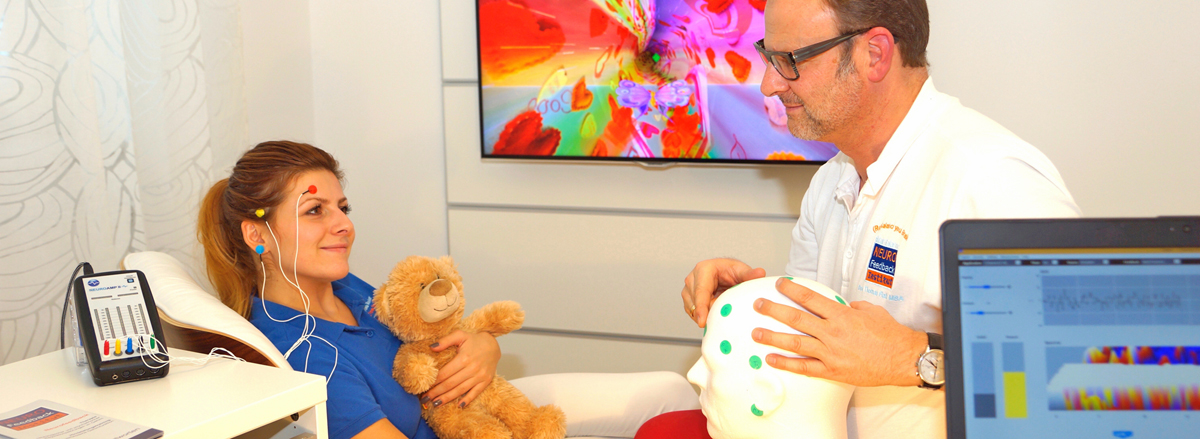
What is Neurofeedback?
Neurofeedback supports the therapy of (behavioral) disorders, which derive from a dysregulation of these brain functions. Neurofeedback was discovered in 1965 at the University of Los Angeles (USA), during a science project of the space agency NASA; since then it was continuously developed.
Today Neurofeedback is being used as behavioural therapy to stabilise the central nervous system without medication.
What ist the difference between Biofeedback and Neurofeedback?
Originally the term Biofeedback described peripheral Biofeedback and Neurofeedback (also known as EEG-Biofeedback). Nowadays, the term Biofeedback often refers to the feedback of physical signals that are directly connected with the vegetative nervous system (for example: heartbeat, respiration and muscle tension). Neurofeedback on the contrary is the feedback of brain activity, therefore training the central nervous system.
What are the indications of Neurofeedback?
The goal of neurofeedback is to regulate and improve neurological and psychological disorders. Depending on the brain region which is trained, Neurofeedback can improve perception, concentration, sleep and behavioural patterns. It can reduce negative symptoms like headache, migraine, depression, anxiety, panic attacks, burnout and traumata.
Is Neurofeedback also suitable for mental Performance enhancement for work/sport?
Neurofeedback is ideal for peak performance training when mental performance is required. Especially in elite sports, neurofeedback is indispensable today. Neurofeedback also supports pupils and students in the mental focus during exam preparation. Top performers from different fields of work, sports and the stage, who want to learn to promote their own mental performance potential and retrieve it precisely, will benefit from Neurofeedback.
How does Neurofeedback work?
Neurofeedback is the feedback of brain activity which is measured in the EEG. The EEG signal is transferred to a computer and converted into an audio / visual feedback. This feedback is coupled to a computer-based reward principle which makes it possible to train the brain to learn new behavioral strategies. Effective learning has positive effects on the excitation, concentration, and relaxation states.
Are there different neurofeedback systems? And which one is the best?
Over 50 years, several procedures have been developed. The “best” system does not exist. Achievements can be accomplished with all neurofeedback methods. In recent years, in addition to one-channel referential training methods such as frequency band training, bipolar training and SCP training (short cortical potentials), the symptom-based ILF approach (Infra Low Frequency) with multichannel derivation possibilities has become increasingly popular. In addition, a diagnostic tool called QEEG (quantitative EEG) can be used to ensure a more specific therapy.
How many treatments are needed?
Every person has his or her own biography, which must be considered individually. Therefore, no exact number of sessions can be mentioned in advance. Based on the expertise of more than 10.000 neurofeedback sessions in our institute, we can see that successful neurofeedback therapy requires approximately 20 to 40 sessions, some people with more severe neurological disorders need more sessions.
How long does the effect of a neurofeedback therapy last?
Neurofeedback is a long-term learning process, similar to swimming or cycling. The brain changes its activity patterns for a long period of time. Studies could demonstrate the learned effects in extensive examinations after six months.
I take medication. Can I still start with Neurofeedback?
Many people who start a Neurofeedback therapy have the desire to reduce or even eliminate their current medications. It is possible to start the therapy while taking medications. But, before the start of the therapy, it has to be discussed, which medications are being taken and which had been taken in the past, during an anamnesis interview.
With the start of Neurofeedback therapy, care should be taken to ensure that the dose of the existing medication is maintained. No other medicines should be taken in addition and none should simply be left out, unless it is medically absolutely necessary. A change of medication should always be discussed with the attending physician!
Is the treatment painful or uncomfortable?
Whether something is unpleasant, is a very personal feeling. The vast majority of our patients think that Neurofeedback a pleasant, relaxing form of therapy.
At what age is it possible to start a Neurofeedback therapy?
A strict age limit is not drawn. Currently, school entry is considered the minimum age. There is no maximum age. Especially older people with declining mental abilities can benefit from Neurofeedback.
Does the statutory / private health insurance pay for the neurofeedback therapy?
In Austria, a reimbursement by the statutory health insurance is not yet provided. Neurofeedback is also still in the protracted process of being included in the standard supply systems in other EU states. However, a positive development is emerging: An increasing number of private supplementary insurances recognize neurofeedback as a valuable alternative form of treatment and replace up to 80% of the therapy costs. Prerequisite for the replacement is a doctor’s prescription or referral.
Do you have further questions?
You are welcome to call us or make an appointment for a personal meeting.
Call: 01 / 913 40 80
